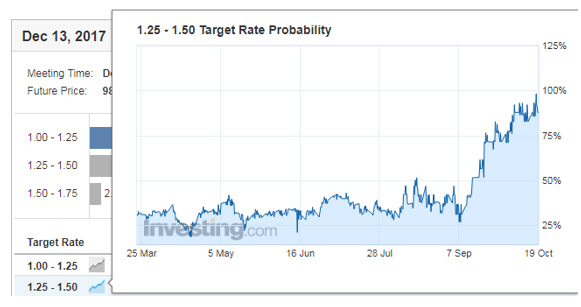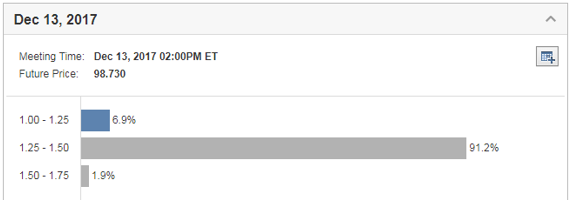By Jason Martin
While traders widely anticipate the Federal Reserve to undertake the next increase in interest rates in December, there is one hike that policymakers and markets seem to have forgotten about in the realm of monetary policy as the US central bank strives to move back towards its goal of policy normalization.
Rate target range created
Flashback nearly nine years to December 2008. At the time, Ben Bernanke was Fed Chair and Janet Yellen was an alternate member of the FOMC. From the December 15-16 meeting minutes:
“The members decided that it would be preferable for the Committee to communicate explicitly that it wanted federal funds to trade at very low rates; accordingly, the Committee decided to announce a target range for the federal funds rate of 0 to 1/4 percent.”
The move was historic not only because it was a new all-time low in interest rates hovering just above the zero bound, but also because it was the first time ever that the Fed decided to move off a specific interest rate target and provide a range instead.
The minutes from that December gathering also revealed an in-depth discussion over what to do with interest rates and “several policymakers” even considered the direct removal of a specific target rate altogether. They argued that it could be helpful as:
“...it would focus attention on the shift in the policy framework from targeting the federal funds rate to the use of balance sheet policies and communications about monetary policy as a way of providing further monetary stimulus.”
The transcripts (which are published on a five-year delay) from that historic meeting later revealed that Janet Yellen herself—and still over five years away from taking over at the helm of the central bank—believed at that time that the Fed “should move the target funds rate all the way to zero”.
It was only her wariness of predicting financial market reactions to new circumstances, specifically a concern shared by other colleagues of taking rates to that bottom limit, that convinced her that “there may be some benefits from allowing the funds rate to trade between zero and, say, 25 basis points.”
It was on December 16, 2008 that the Fed announced the historic decision to convert their interest rate target to a range, a tool that remained intact even seven years later when the central bank finally began to tighten policy at the end of 2015. Indeed, the following three hikes in December 2016 and twice this year followed the same policy pattern by hiking both the lower and upper bound of the range each time by 25 basis points to reach the current 1.00% to 1.25%.
Yet most seem to have forgotten that an interest rate range is not the norm, as economists continue to deliver their forecasts according to that formula.
Pouring over the transcripts from that historic discussion nine years ago, only St. Louis Fed President James Bullard seemed to contemplate an eventual return to normalization At that time, he said:
“Once the crisis is past, then we can begin setting a federal funds target again, maybe coming back with a range initially for the federal funds rate and then gradually moving back into the targeting regime, which I agree in normal times is a much better way to communicate policy.”
Next step in policy normalization
With the first rate hike since the crisis back in December 2015, the Fed began its move towards policy normalization. The central bank took another large step last September by announcing that it would embark on the tapering of its asset purchases.
With extraordinary policy measures being slowly wound down, the path is clear for the Fed to step back from its focus on the use of balance sheet policies as the means of providing monetary stimulus and the final, logical piece of the puzzle would be the removal of the lower bound on the current target range to refocus on that “much better way to communicate policy.”
According to Investing.com’s Fed Rate Monitor Tool, markets became convinced that the Fed would move again in December following the last policy announcement and have recently increased the odds for the central bank to hike by another 25 basis points to around 93%.

Indeed, market participants have slowly begun to price in minimal odds for a further increase to 1.50%-1.75%.

That’s despite the fact that some Fed policymakers have noted their concerns about subdued levels of inflation and suggested that they would like to see further evidence of it moving back towards the 2% target before taking the next step in policy tightening.
“Our understanding of the forces driving inflation is imperfect, and in light of the unexpected lower inflation readings this year, the Committee is monitoring inflation developments closely,” Yellen admitted in the September press conference.

Core PCE price index Y/Y, considered the Fed’s preferred inflation indicator. Source: Bloomberg
Despite concerns over inflation, the Fed has largely shown itself to be determined to forge ahead with its “gradual” increases to the funds rate as part of its current path to policy normalization.
Barring a major downward shock to inflation figures between now and the December 12-13 meeting (the November consumer price index will be released on the same day as the decision) and given markets’ current acceptance of the move coming at the end of the year, we believe that the Fed has the green light to move forward. But the question remains as to whether the Fed will also move forward with returning its interest rate policy to a specific target.
Weak inflation data could support the view of more dovish members to proceed with caution and provide an opportunity for the Fed to effectively increase the target rate by just 12.5 basis points by removing the range and keeping the target at the current upper bound of just 1.25%.
On the other hand, stronger inflation figures could provide an argument to couple the increase with a “return to policy normalization” by removing the range and once again establishing the Fed fund rate at “just” 1.50%, equivalent to an effective increase of 37.5 basis points in interest rates.
Granted, December does not have to be the “do or die” moment for the Fed to take the next step towards policy normalization by undoing range targeting. However, it may well be, in Fedspeak, the “appropriate” moment to take the plunge.
The introduction of the range was implemented in a move that took rates below 1%. Currently they are above that level and set to move higher.
Balance sheet unwinding is on course and the December decision coincides with a press conference that will allow Janet Yellen to explain the action. If the Fed is truly set on policy normalization, the target range is, for now, the last man standing.
